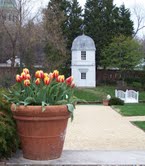Content

Plants of the 18th Century in The William Paca Garden, Annapolis, Maryland
This two acre oasis of natural beauty was laid out by William Paca when he built his house. Although many colonial Annapolitans had gardens, only Paca’s has been returned to its original splendor and opened to the public.
Archaeologists found remnants of the original brick garden wall, three outbuildings, the pond and the canal. The background of Paca’s portrait documented the architectural details of the two-story summerhouse, the Chinese-style bridge over the pond and the brick bath house. Eighteenth century garden manuals and plant lists provided more clues from the period. Garden historians and horticulturists used all this information to recreate an 18th-century landscape.
The Garden Wall and Terraces define the spaces and views of this elegant garden. Terraces or “falls” were a characteristic of colonial gardens in the Chesapeake region. Slopes in the stone foundation of the garden wall told archaeologists where the falls were located so that terraces could be reconstructed. The upper level serves as a platform for entertaining and viewing the garden. The vertical slits in the wall, based on the Paca portrait, are thought to encourage air circulation in hot humid weather.
The Parterres, precise geometric designs that demonstrate human control over nature, occupy the middle terraces. The rose parterre is filled with heirloom varieties, while the flower parterre provides three seasons of colorful bloom. The holly and boxwood parterres exhibit the art of sculpting living plants into topiary.
Plants of the 18th Century are known from books and letters. Roses, perennials and annuals in the parterres are authentic to the colonial period. The vegetable garden provides fresh delicacies such as salad greens, peas and asparagus. In the fruit garden heirloom varieties of apples, pears, plums, cherries and figs are carefully trained into espaliers and cordons to take advantage of limited space in an urban garden. Some of these include:
Water in the garden has always been a problem. Paca designed a system of drains to divert excess water into charming garden features. The brick canal carries runoff across the garden. The spring house captured water for household use and provided cool storage for milk and butter. Uncovered beneath the hotel parking lot, the same spring feeds the spring house today and flows through a brick channel to fill the fish-shaped pond. Wooden baffles diverted water through another underground passage to the bath house.
The Summer House, reconstructed from Paca’s portrait, serves as a focal point in the garden. On its upper floor the Paca family could view the garden, entertain guests and catch cool summer breezes. The Chinese-style bridge provides a path over the pond to this inviting garden retreat.
The Wilderness reflects the picturesque style of gardening that was fashionable in England after 1740. Serpentine pathways meander between beds of mixed plantings. The emphasis is on native plants of North America that had been brought into cultivation by Paca’s time.
For more information: www.annapolis.org




